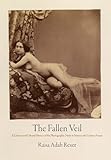The Fallen Veil : A Literary and Cultural History of the Photographic Nude in Nineteenth-Century France / Raisa Adah Rexer.
Material type: TextSeries: Material TextsPublisher: Philadelphia : University of Pennsylvania Press, [2021]Copyright date: ©2021Description: 1 online resource (328 p.) : 87 halftonesContent type:
TextSeries: Material TextsPublisher: Philadelphia : University of Pennsylvania Press, [2021]Copyright date: ©2021Description: 1 online resource (328 p.) : 87 halftonesContent type: - 9780812297850
- French literature -- 19th century -- History and criticism
- Literature and photography -- France -- History -- 19th century
- Nude in art -- History -- 19th century
- Photography of the nude -- History -- 19th century
- Photography -- Social aspects -- History -- 19th century
- LITERARY CRITICISM / European / French
- Cultural Studies
- European History
- Literature
- World History
- 840.9 23
- PQ283
- online - DeGruyter
| Item type | Current library | Call number | URL | Status | Notes | Barcode | |
|---|---|---|---|---|---|---|---|
 eBook
eBook
|
Biblioteca "Angelicum" Pont. Univ. S.Tommaso d'Aquino Nuvola online | online - DeGruyter (Browse shelf(Opens below)) | Online access | Not for loan (Accesso limitato) | Accesso per gli utenti autorizzati / Access for authorized users | (dgr)9780812297850 |
Frontmatter -- CONTENTS -- Preface -- PART I The Second Empire -- Chapter 1 Art, Obscenity, and Censorship: 1839–1870 -- Chapter 2 The Judgment of Phryne, or, The Model’s Meaning -- Chapter 3 Baudelaire’s Bodies -- Chapter 4 Manette Salomon and Anti- Modernity -- PART II The Third Republic -- Chapter 5 The Rise of an International Industry: 1870–1900 -- Chapter 6 The Dangerous Streets -- Chapter 7 Nana in the Nude -- Chapter 8 Maizeroy and the Feminist Photo- Novel -- Conclusion -- Notes -- Bibliography -- Index -- Acknowledgments
restricted access online access with authorization star
http://purl.org/coar/access_right/c_16ec
Between 1839 and the end of the nineteenth century, millions of nude photographs of the female form—artistic, pornographic, and everything in-between—were produced in France, the birthplace of photography. Drawing upon government records, legal decisions, newspaper accounts, and contemporary literature, Raisa Rexer recounts the history of these illicit and ubiquitous images and elucidates their immense cultural and artistic reach.Rexer focuses in particular on the ways that nude photographic imagery influenced some of the greatest authors of the period, including Charles Baudelaire, the Goncourt brothers, and Émile Zola, and sets their work against historical records and nonfiction print sources to tell the story of evolving perceptions of nude photography. In the period immediately after photography's invention, nude photographs were vitally connected to the questions of art and artistry, particularly with regard to photography's aspirations to high cultural status. By the end of the century, however, as production and sales expanded internationally and as photographs of nudes flooded the streets and shops, proliferation of these pictures was increasingly viewed as one of a host of social problems plaguing France.Illustrated with nearly ninety period images, The Fallen Veil offers the first full treatment of the photographic nude in the nineteenth century and considers how this history continues to influence many of the same questions we ask today about art, pornography, and the relation between the two.
Mode of access: Internet via World Wide Web.
In English.
Description based on online resource; title from PDF title page (publisher's Web site, viewed 25. Jun 2024)


